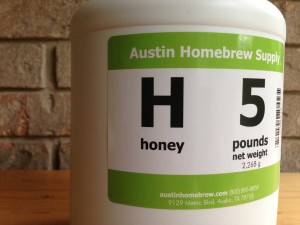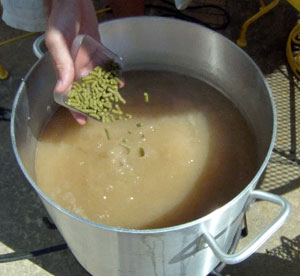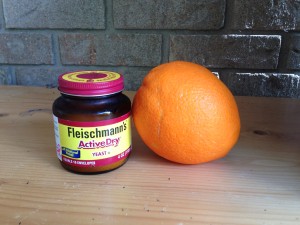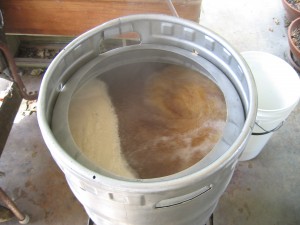The start of “brewing season” is almost upon us. Brewing season is that time of year when temperatures fall low enough to allow most homebrewers to ferment ales with little or no active temperature control. James and I have got a bit of a jump on brewing season with some recent brewdays. Here’s what we are working on right now. What are you brewing?
Archives for August 2013
5 More Big Beer Fermentation Tips
 Yesterday, I ran down the top 5 tips for successfully fermenting a big beer. Here’s 5 more tips to help you.
Yesterday, I ran down the top 5 tips for successfully fermenting a big beer. Here’s 5 more tips to help you.
6.) Aerate Your Wort Thoroughly
Yeast — of which you should have pitched an adequate amount — require oxygen for a healthy fermentation. Besides aerating the batch immediately before pitching, you can aerate your yeast starter several hours before pitching to help prepare the yeast. (Just pour out most of the liquid and aerate that which remains.) Or, better yet, pour a small amount of fresh, well-aerated wort (around SG 1.010–1.020) on the yeast sediment in your starter a few hours before pitching it to the main batch.
In very high gravity beers, you can even aerate after the start of fermentation. Eight to 12 hours after pitching — when fermentation has started, but before high kräusen — give the yeast a second shot of oxygen. Once the fermentation passes high kräusen, do not aerate again as this can cause your beer to have unacceptably high levels of diacetyl.
Five Tips for Fermenting Big Beers
Fall is almost here and now is the time to start brewing your big beers to have them ready for the cold nights this winter. One of the biggest keys to brewing a good strong beer is to conduct a healthy fermentation. Today I’ll post the top 5 keys to doing that, and tomorrow I’ll post the next 5.
1.) Pitch an Adequate Amount of Yeast
Pitching enough yeast will result in your fermentation getting a good, quick start. A fast start to fermentation limits the potential for contaminants to get a foothold in your beer. In a big beer, that may be aged extensively, this is a big benefit. Consult a yeast pitching rate calculator to determine how much yeast to pitch.
Mjollnir Recipe
This is an example of a beer brewed using the reiterated mash technique. This recipes makes for a long brewday, and there is a compromise between getting the best extract efficiency from each mash, which is important to reaching a high original gravity, and the amount of time spent. In addition, this is a challenging fermentation for the yeast. Do not skip making the yeast starter and do not forget to add yeast nutrients.
Mjollnir (Reiterated Mash)
English units
DESCRIPTION
A very strong beer that is light in color. If everything goes right, you will make a very fermentable wort on brewday and achieve a high degree of attenuation in the fermentation. This will make a beer that is full-bodied (but not overly chewy or sweet), well-balanced and very drinkable considering its strength.
Reiterated Mashing: Practical Advice
Yesterday I introduced my idea of reiterated mashing, inspired by the brewers of Samichlaus. (I say, “my idea,” but I’m sure many brewers through history have had similar thoughts. In his book, “Radical Brewing,” Randy Mosher describes the same basic idea from early England.)
The basic idea is to use wort as your brewing liquor for a high-gravity batch of beer. So, you mash once to make your brewing “water” and again with wort to make your high-gravity wort. One way to look at reiterated mashing, and to understand when you might want to use it, is to compare how it concentrates the wort compared to other, standard ways of brewing.
To brew a big beer normally, you would collect a lot of wort and boil it for a long time. You would end up with a high-gravity wort because you boiled off lots of water. Another way to make a big beer is to add malt extract. In this case, the manufacturer of the malt extract would have boiled off (and otherwise evaporated) lots of water for you. In reiterated mashing, you don’t concentrate the wort in the kettle by applying heat and evaporating water; you concentrate the wort via simple diffusion in the mash tun. Because of this, you get much less color in the wort. You could brew a dark colored beer this way, but the other, “regular” ways of making a big beer would be faster. Reiterated mashing is best used for making a very high-gravity beer with very little color.
Reiterated Mashing: Theory and Planning

An example of how reiterated mashing could work at home. The grain bed will absorb some liquid each time; that is why the brewing liquor amounts decrease each round. Also, note that if you simply mashed 20 lbs. of grain all at once, you’d have 12 gallons of wort at 1.043 on your hands (presuming you sparged proportionally to this example.)
A few years ago, I was on a big beer kick. One of the big beers I brewed was a Samichlaus clone, a 14% ABV doppelbock. In my research into the beer, I found out that Hürlimann (the original brewers) used the late runnings from a previous beer for their strike water — essentially they were using low-gravity wort for a portion their brewing water. (Treated brewing water, with all the minerals added, is also called brewing liquor.)
The thought occurred to me, what if I made a batch of full-strength wort and used that for all of my brewing liquor? I could make an all-grain wort that was more concentrated than normal, allowing me to brew an all-grain, high-gravity beer without an extended boil. Also, I could do this without adding sugar or malt extract in the kettle. So I thought it through, brewed a few test batches — on my own and with friends — and called the technique reiterated mashing.
I knew that mashing twice in one day — once to make the brewing liquor and once for the main batch — would be time-consuming. And, I also knew I’d be using about twice as much grain as on a normal brewday, so I tried to plan everything out carefully, so I wasn’t wasting either time or grain. In today’s article, I’ll explain the theory behind reiterated mashing. Tomorrow, I’ll explain the practical elements based on my test batches and also give a recipe.
Old School Mead Recipe
Yesterday, I posted a mead recipe for first time mead makers. The recipe was designed to not only yield great mead, but also have a high probability of success. Part of the likelihood of success would be due to taking into consideration some of the newest ideas in mead making — the potassium levels of the mead, the pH and using staggered nutrient additions to help the fermentation along.
Today, I present a somewhat different type of mead recipe. This has been floating around the internet for some time, and quite a few people have been tried it and liked it. It may seem a bit “rustic” to advanced homebrewers or mead makers, but I’d just like to point out a few things before leaving it up to you to decide on the merits of this recipe.
Oranges are relatively high in potassium. Raisins are also fairly high in potassium. The combination of raisins and spices is going to add a small amount of tannins. (And in wine, tannins lend “structure.”) Fleishmann’s yeast is going to drop out early and leave a sweet mead. In wine, sweetness is balanced by acidity and oranges are loaded with citric acid. And finally, others have hit on the same combination of ingredients, more or less (although it’s possible that both of these draw from an older source). In any case, presented for your consideration, here’s Joe’s Ancient Orange Mead.
Dive Into Mead Making

Honey is the basis of mead. But honey alone can be difficult to ferment. Making a fruit mead (or melomel) is a great way to get started with meadmaking.
Here is a mead recipe for first time meadmakers who would like to try something with a high probability of success. One problem with making mead from honey alone is that there may not be enough potassium in the honey to sustain a healthy fermentation. Additionally the pH of an all-honey mead must may initially be too low. This recipe combines honey with cherries, a fruit with relatively high potassium levels, and whose juice is in a suitable pH range. (The pH of sweet cherry juice ranges from 3.8–4.5). It also contains a small amount of grape juice, which also has fairly high potassium levels and whose juice pH will work well in a wine-like fermentation. (Most wine is made from grapes.) Even if the pH of the honey is low, the fruit juices are more highly-buffered, so it will not be a problem.
One thing that might make beer brewers nervous is the lack of sanitation. The mead must is not boiled, nor are Campden tablets used to inhibit microorganisms, as in winemaking. The “dump and stir” method, advocated by Ken Schramm and employed here, works if you keep everything that goes into your must or contacts the fruit as clean as possible.
This recipe uses staggered nutrient additions to speed the fermentation along. Mead does not require fermentations that span for 6 or more months, as was the norm in “old school” meadmaking. If the yeast are fed nutrients as they need them, and in the right quantities, a mead fermentation can proceed nearly as quickly as a beer fermentation and aging may take only several weeks.
Although this is a “beginner’s” recipe, the quality is not substandard. If you use fresh, flavorful cherries and quality honey, following the instructions here will produce a wonderful mead.
Meads made with fruit are called melomels, so you can call this either a cherry mead or a cherry melomel. (Meads made from only honey and grapes are sometimes called pyments.) This produces a mead of 12% ABV. It’s strong, but not so strong that it will tax the wine yeast and lead to a prolonged fermentation. If you’re interested in mead and have been looking for a place to start, consider this recipe.
Skim the Scum?
When your wort first comes to a boil, the foam rises to the top of your kettle and often has darker brown clumps of “scum” amidst the light tan foam. Likewise, during fermentation, the white/tan kräusen often has dark clumps in it. The Germans call this braun hefe (literally brown yeast). Many homebrewers wonder if they should skim the boil scum and/or braun hefe.
Before answering these two questions, I should point out that there are techniques in brewing that clearly lead to demonstrably better beer and there are techniques whose influence on quality is much smaller (fading into undetectable). In both these questions, the latter is definitely the case. The short answer to this question is that a few breweries skim (at one or both stages), but most don’t. Skimming is not something that is going to make or break the quality of your beer. In fact, you may not even be able to tell a difference. Still, let’s take a look at each case a little more closely, in order to get a more complete answer.
Pumpkin Ale, by Mark Pasquinelli

A glass of pumpkin ale, ready to be enjoyed on a fall evening. Despite adding pumpkin to the boil, the beer is clear and keeps well. (Photo courtesy Mark Pasquinelli.)
In the early years of the craft beer revolution, pumpkin beer was a novelty — something that stood out from usual the assortment of pale ales and stouts. Nowadays, it’s a standard seasonal release. And that release date keeps coming earlier and earlier, with breweries and brewpubs racing each other for the earliest date. One brewery even joked that this year’s August release was for the 2014 edition. At this rate, it’s bound to become the first year-round seasonal beer.
I live in the northeast, where pumpkin beer is a harbinger of crisp fall weather and spectacular foliage. I’m compelled to order one whenever I have the opportunity. Unfortunately, I’m often disappointed. Many are watery with unassertive spice profiles, or don’t use any pumpkin. But that’s not a problem. I’m a homebrewer. If I want something done right, I can do it myself.





Recent Comments